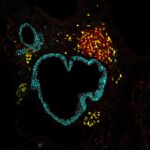
Publication: Early posttransplantation donor-derived invariant natural killer T-cell recovery predicts the occurrence of acute graft-versus-host disease and overall survival.
Publié dans: Blood 2012 Sep; 120(10): 2144-54
Auteurs: Rubio MT, Moreira-Teixeira L, Bachy E, Bouillié M, Milpied P, Coman T, Suarez F, Marcais A, Sibon D, Buzyn A, Caillat-Zucman S, Cavazzana-Calvo M, Varet B, Dy M, Hermine O, Leite-de-Moraes M
Résumé
Invariant natural killer T (iNKT) cells can experimentally dissociate GVL from graft-versus-host-disease (GVHD). Their role in human conventional allogeneic hematopoietic stem cell transplantation (HSCT) is unknown. Here, we analyzed the post-HSCT recovery of iNKT cells in 71 adult allografted patients. Results were compared with conventional T- and NK-cell recovery and correlated to the occurrence of GVHD, relapse, and survival. We observed that posttransplantation iNKT cells, likely of donor origin, recovered independently of T and NK cells in the first 90 days after HSCT and reached greater levels in recipient younger than 45 years (P = .003) and after a reduced-intensity conditioning regimen (P = .03). Low posttransplantation iNKT/T ratios (ie, < 10(-3)) were an independent factor associated with the occurrence of acute GVHD (aGVHD; P = .001). Inversely, reaching iNKT/T ratios > 10(-3) before day 90 was associated with reduced nonrelapse mortality (P = .009) without increased risk of relapse and appeared as an independent predictive factor of an improved overall survival (P = .028). Furthermore, an iNKT/T ratio on day 15 > 0.58 × 10(-3) was associated with a 94% risk reduction of aGVHD. These findings provide a proof of concept that early postallogeneic HSCT iNKT cell recovery can predict the occurrence of aGVHD and an improved overall survival.
Lien vers Pubmed [PMID] – 22730537
Lien vers le DOI – 10.1182/blood-2012-01-404673

